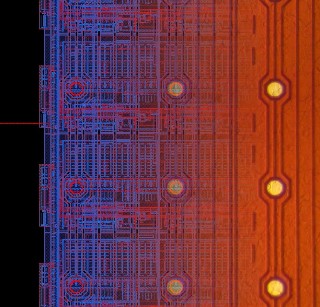Oct 8 2014
Julia H. Smith is a postdoctoral fellow working on detectors for the SwissFEL x-ray free electron laser, which can be envisioned as “the eyes” of the new PSI large-scale facility. During her time at PSI, she has a good chance of accompanying “her” detector up to its use at the new facility.
 Part of a prototype of a Jungfrau detector chip: As seen under a microscope (right) and the pixel structure (left) are overlaid. The nine pixels are connected with each other in a complex way. Detector modules for the SwissFEL are made of millions of such tiny pixels. Graphics: Aldo Mozzanica.
Part of a prototype of a Jungfrau detector chip: As seen under a microscope (right) and the pixel structure (left) are overlaid. The nine pixels are connected with each other in a complex way. Detector modules for the SwissFEL are made of millions of such tiny pixels. Graphics: Aldo Mozzanica.
“Even more important than witnessing the first experiments at SwissFEL is acquiring new knowledge and skills during my time as a postdoc at PSI.” Smith would like to continue working in the field of detectors and technology development after her postdoc – at a company or at another research institute.
In the future, the x-ray free electron laser SwissFEL will reveal details of ultra-fast processes that cannot be seen with the naked eye or a camera. Highly specialised detectors, virtually the eyes of the new facility, are needed to record these processes. Julia H. Smith from Germany is working on the development of such a detector. The young scientist has decided to move to Villigen as a postdoctoral research fellow – in short postdoc – after completing her doctorate in Amsterdam. This “research exchange” is very important to Julia Smith. “The work in this detector group is the piece of the puzzle that I was still missing”, she says. In her previous research, the physicist took an in-depth look at the practical applications of pixel detectors. At PSI, Smith has taken one step back and is involved in the initial stage, in the development phase, of a detector.
Monumental like a real mountain
Developing such a specialized device from scratch is not only highly instructive but also very demanding. The pixel detectors Julia Smith is tinkering with contain highly complex miniaturised technology. Precision and expertise are needed from the construction of the individual components down to the building of the first prototype. A pixel detector consists of many individual pixels. Each of these tiny pixels can receive signals, or to be more precise, individual x-ray light particles. At the SwissFEL, the light particles will be used, amongst other things, to study molecular reactions, for instance how two atoms or molecules form a bond. In the experiments, the molecules under study deflect the SwissFEL light particles away from their straight path. The light impinges on a detector which registers information about the deflection. A computer then calculates the images and reconstructs the course of the reaction.
Julia Smith is as familiar with a pixel detector as other people are with their Smartphones. Nonetheless, she doesn’t overdo the jargon. She teaches in the iLab, the PSI lab school, and explains the way a detector works as if it was the least complicated thing in the world. All in all, a development period of about five years is required to successfully launch a detector like “Jungfrau” – the specific detector which Smith is currently working on. The requirements are stringent: “Jungfrau” must be able to simultaneously visualise a spectrum ranging from one to 10,000 light particles.
A monumental piece of work that deserves being named after the mountain in the Bern Alps. “A project of this kind can only be tackled in a team”, stresses the postdoc. While one of Smith’s colleagues attends to, for instance, the design of the pixels themselves, i.e. the detector chip, another focuses on how to read out the measured information.
Test successful - detector ready for use
In the team, the researcher is responsible for testing the chip. She uses a small test laser in the group’s lab or works at the SLS, a large-scale research facility that already now generates intensive x-ray light at PSI. How do the pixels react to the laser light? How do they pass on information? Is everything working as it should? Smith examines these questions and has just tested the second Jungfrau prototype. It passed the test. Smith is happy that the detector is ready for the SwissFEL. The next step is to build and then test the final detector.
During her time at PSI, Julia Smith has a good chance of accompanying “her” detector up to its use in the SwissFEL facility. The researcher comments, “Learning as much as possible during my postdoc is even more important than witnessing the first experiments.” After all, the goal is to extend her expertise. After her postdoc, Smith would like to stay in the field of detectors and technology development in a company or at another research institute. She’s very interested in the topic. “I’m fascinated by pixel detectors because each one of these minute pixels is a small detector itself. When linked to all the others, an incredible performance can be achieved.” Her toolbox for the further development of these complex systems will definitely be complete after her postdoc at PSI.
Source: http://www.psi.ch/